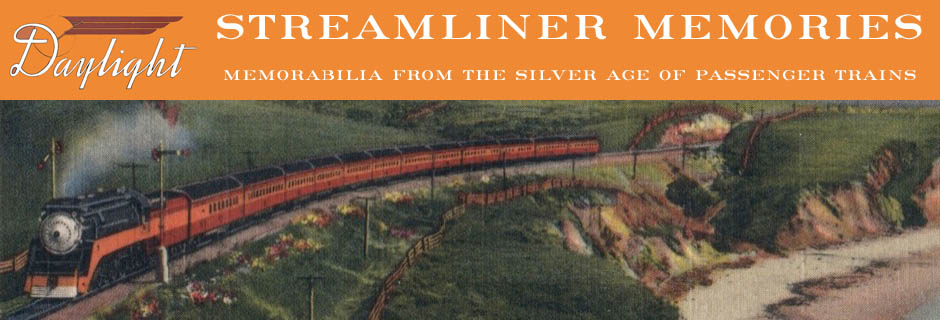In about 1980, Passenger Train Journal called the California Zephyr “the classic train of our time” even though the Chicago-Oakland train had stopped running a decade before. What made the CZ special was that, as one ad said, it was the first transcontinental train “designed and timed [more] for sightseeing” than for getting from one place to another. While only the third train to have dome cars, it was the first to travel through scenery that truly deserved dome cars.
When the California Zephyr began running in 1949, the City of San Francisco was still on a 39-3/4-hour schedule aimed at attracting business travelers. The California Zephyr required 10-1/2 hours more, so rather than compete with the City on time, the Cal Zephyr competed on scenery: it was timed so that passengers could see the best scenery in Colorado, Utah, and California in daylight, while they slept through the relatively boring parts across Nevada and the Great Plains. The domeless City train, by comparison, crossed relatively desolate southern Wyoming during daylight hours and went over the scenic Sierra Nevada at night.
 Click image to download a 2.0-MB PDF of this 20-page brochure.
Click image to download a 2.0-MB PDF of this 20-page brochure.
Both the cover and page 3 of the above brochure, which was published two months before the train began running, emphasizes the same Feather River Canyon location featured in yesterday’s brochure about the Exposition Flyer. Yet, as future advertising would reveal, there was much more to see along the way, including the Colorado Rockies; the Flatirons above Boulder; Ruby, Gore, Glenwood, Red, and other canyons in Colorado; Williams Loop in California; and lots more.
The train itself nominally consisted of a baggage car; three 46-seat dome coaches; a dome-buffet car; a full diner; four sleeping cars; and a dome-observation-lounge car. Initially, the four sleepers included one with sixteen sections (32 beds) and three with ten roomettes and six double bedrooms (known as a “10-and-6” for a total of 22 beds). The observation car also had a drawing room (which featured a shower) and three double bedrooms (9 beds). To meet demand, a six-bedroom, five-compartment (22 beds) car was added in around 1950. The domes in the coffee shop and observation cars were reserved for sleeping-car passengers while the other three domes were open to all passengers.

Because Haywood-Wakefield seats were so comfortable, many people who might have paid the nominal amount to travel in a section elected to go by coach instead. So in the early 1960s the railroads converted the 16-section sleepers to 48-seat flat-top coaches that ran in front of the dome coaches. In place of the sections they added another 10-and-6 sleeper. Along with the a six-bedroom, five-compartment sleeper that had been added in around 1951, this increased the capacity over the original trains by 48 seats and 12 beds.
The people who planned the train agreed that they didn’t want the up-and-down window patterns created by duplex roomettes. But the railroads readily accepted through sleeping cars from other railroads, so–though not shown in publicity photos–there were often several colors of cars in the train other than stainless steel. In particular, the Pennsylvania (which even owned a 10-and-6 sleeper in CZ colors) and New York Central alternated with a through car to and from New York City, but other railroads whose cars might be on the CZ (usually for tour groups) included the Baltimore & Ohio, Chesapeake & Ohio, Louisville & Nashville, Norfork & Western, Rock Island, Pere Marquette, Southern, and even western roads including Great Northern, Santa Fe, Southern Pacific, and Union Pacific.

The California Zephyr proved to be a very popular train. In its 1959 annual report, the Rio Grande claimed that, through its first decade, the train operated 89.4 percent full. Much of that time, the coaches were 100 percent full while the sleeping cars were less than 100 percent full only because some people reserved bedrooms for one even though they were designed for two. The original train typically operated with one less dome and one less 10-and-6 sleeper in the winters, but that means it still carried (and mostly managed to fill) 72 percent as many revenue seats as in the summers.
This is an incredible record considering that competitor City of San Francisco typically ran only about 60 percent full. In 2011, which was supposed to be a record year for Amtrak, the modern California Zephyr filled just 59 percent of its space, and only two Amtrak trains–the Adirondak and Carolinian–managed to fill more (but barely more) than 80 percent of their seats. One reason why the CZ was able to fill so many more seats is that most of its patrons went the entire distance between Chicago and Oakland, while most other trains had intermediate travelers who left empty seats when they got off the trains.
